Porsche celebrates 20 years of the 911 GT3 in 2019
Porsche GT3 996, 996 & 991
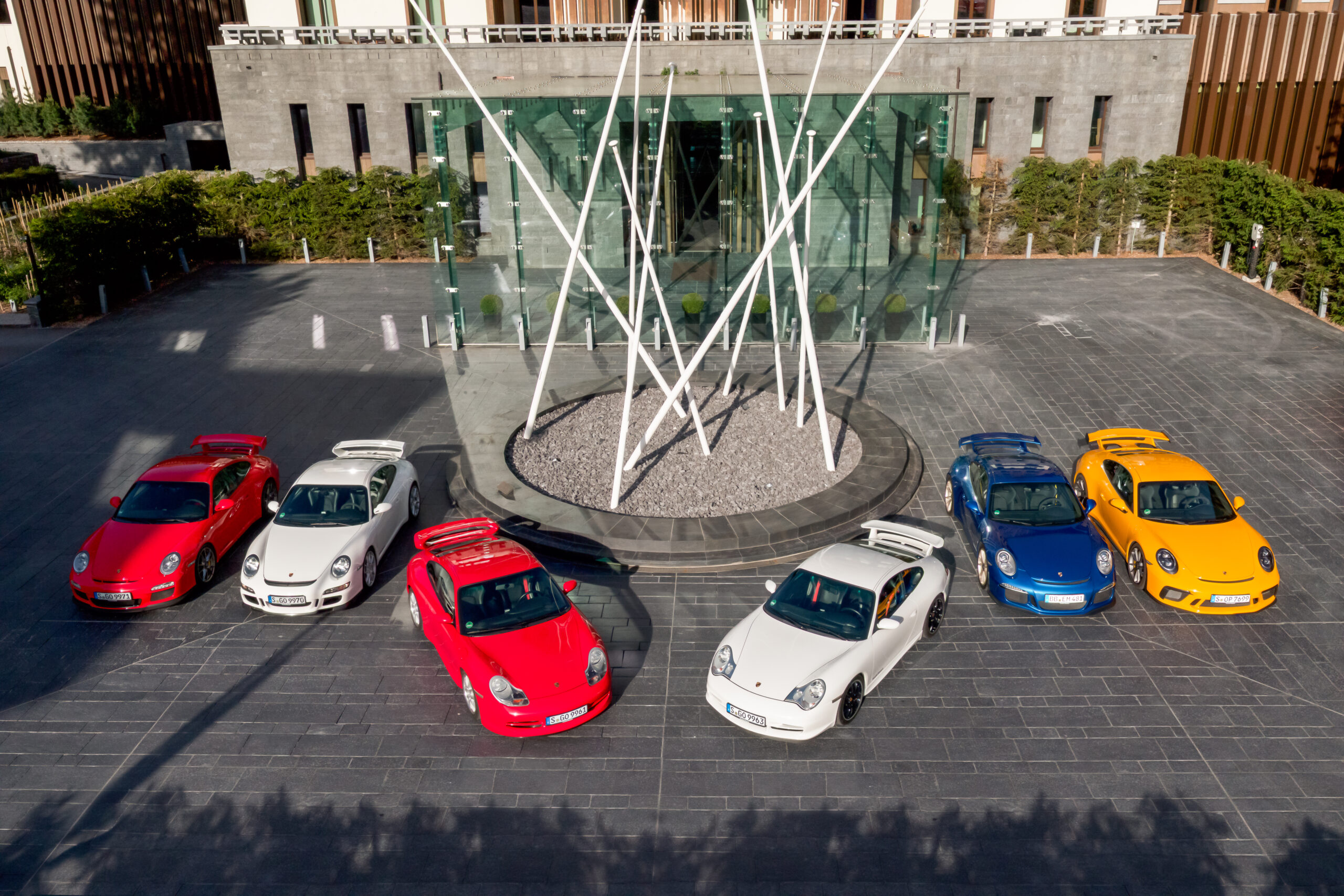
In 1999, the inaugural 911 GT3 model made its debut in the European market, heralding a new era of performance for Porsche enthusiasts. It made headlines by becoming one of the first production cars to conquer the iconic Nürburgring-Nordschleife circuit in under 8 minutes, achieving a remarkable time of 7:56.33 minutes, driven by the legendary rally driver Walter Röhrl.
Setting itself apart from the rear-wheel-drive 911 Carrera models, the 911 GT3 boasted distinct visual cues, including a 30 mm reduction in ride height, a prominent front fascia, visible side skirts, and a fixed rear wing. These design elements were meticulously crafted to minimize lift while maintaining an impressive 0.30 drag coefficient. Notably, the rear wing's angle of attack was adjustable for optimal performance on closed-course tracks.
Under the hood, the original 911 GT3 was propelled by a potent 3.6-liter naturally aspirated flat-six engine, delivering 265 kW (360 PS) of power. Derived from the Le Mans-winning Porsche 911 GT1 race car, this engine revved up to an exhilarating 7,800 rpm. Paired exclusively with a six-speed manual transmission borrowed from the 911 GT2 (993 generation), the first 911 GT3 achieved a top track speed of 187 miles per hour.
True to its track-focused nature, the GT3 model featured staggered 18-inch wheels and tires, along with larger brakes compared to the 911 Carrera. A standard limited-slip differential, combined with an upgraded suspension system, allowed for precise mechanical adjustments of anti-roll bars and suspension geometry, tailored for optimal performance on closed-course tracks.
Embracing weight-saving measures such as the removal of air-conditioning and rear seats, the 911 GT3 tipped the scales at a mere 2,976 lbs. (1350 kg), further enhancing its agility and responsiveness on the track. This holistic approach to performance engineering solidified the 911 GT3 as a formidable contender in the realm of sports cars, laying the foundation for a legacy of motoring excellence that continues to thrive to this day.
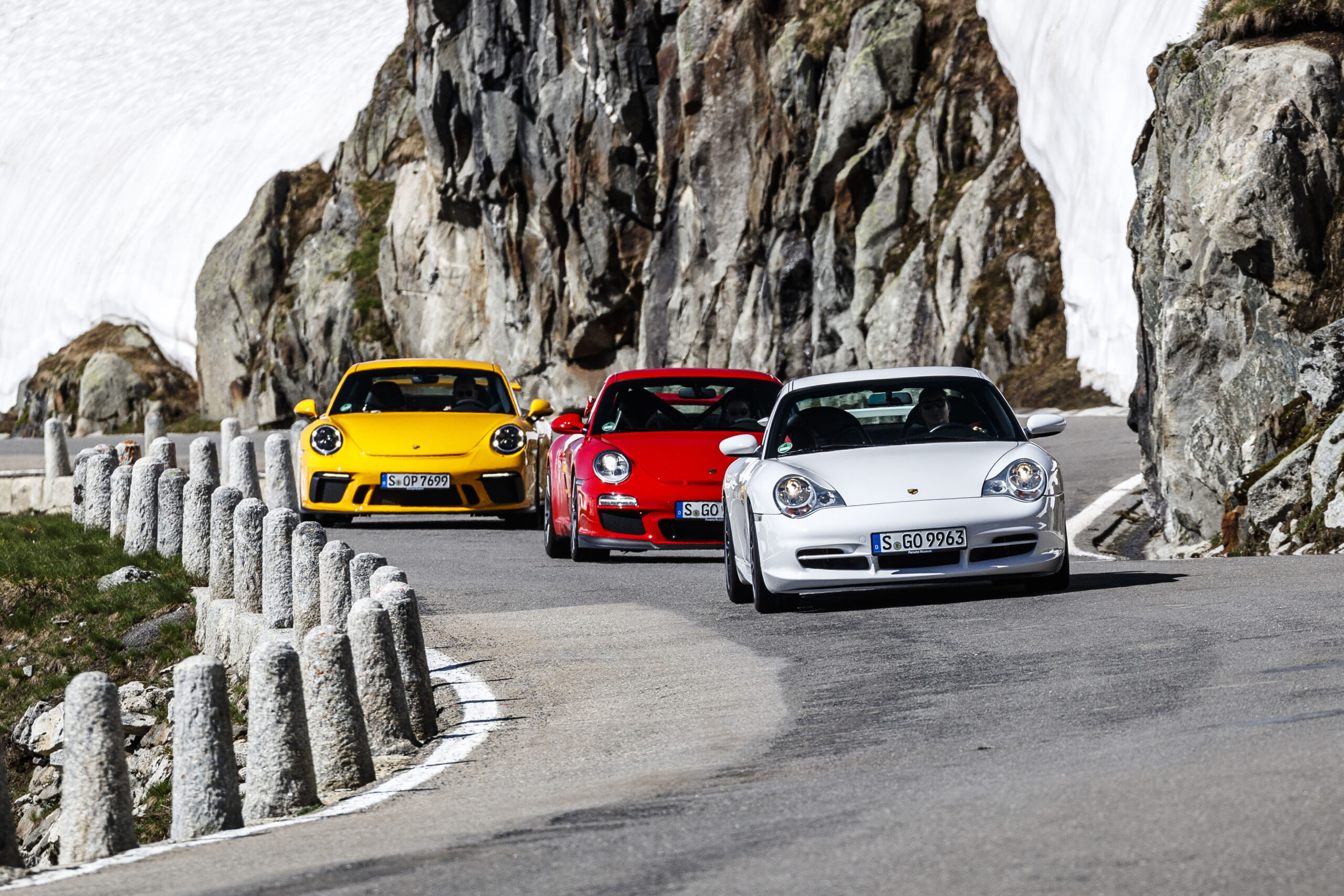
Four years later, the 911 GT3 underwent significant enhancements and made its debut in North America for the first time. Building upon the facelifted 996 generation 911 platform, the 911 GT3 received a substantial power boost, with horsepower increased to 381 and torque elevated from 273 to 285 lb-ft. The redline was also raised to an impressive 8,200 rpm.
These performance gains were achieved through a series of meticulous updates to the engine. Longer titanium connecting rods, lighter pistons, and the implementation of the variable camshaft adjustment system known as VarioCam contributed to the power increase. Furthermore, lighter intake and exhaust valves were introduced, further optimizing the engine's efficiency and responsiveness.
With these enhancements, the 2004 model year 911 GT3 demonstrated blistering performance, sprinting from 0 to 60 miles per hour in just 4.3 seconds and reaching a top track speed of 190 miles per hour. The car retained its six-speed manual transmission, albeit with modified gear ratios for gears five and six to better exploit the increased power and torque.
Visually, the 911 GT3 received updates to its fasciae, including a redesigned rear wing and updated wheel design. Wider front and rear tires were also introduced to enhance grip and handling prowess on both road and track. Notably, the Motorsport department's commitment to weight reduction was evident in the adoption of a new wheel/tire combination utilizing flow-formed wheel technology, which saved 2.2 lbs despite the larger size.
Further enhancing performance, the 911 GT3 saw an upgrade in its braking system, with larger front brake rotors measuring 350 mm (up from 330 mm) and 6-piston calipers. This improvement increased pad-to-rotor contact by approximately 40 percent, ensuring exceptional stopping power and control. Additionally, for the first time in the GT3 lineup, Porsche Ceramic Composite Brakes (PCCB) featuring carbon-ceramic brake rotors were offered as an option, a technology borrowed from the 996-generation 911 GT2, further elevating the car's track capabilities and overall performance.
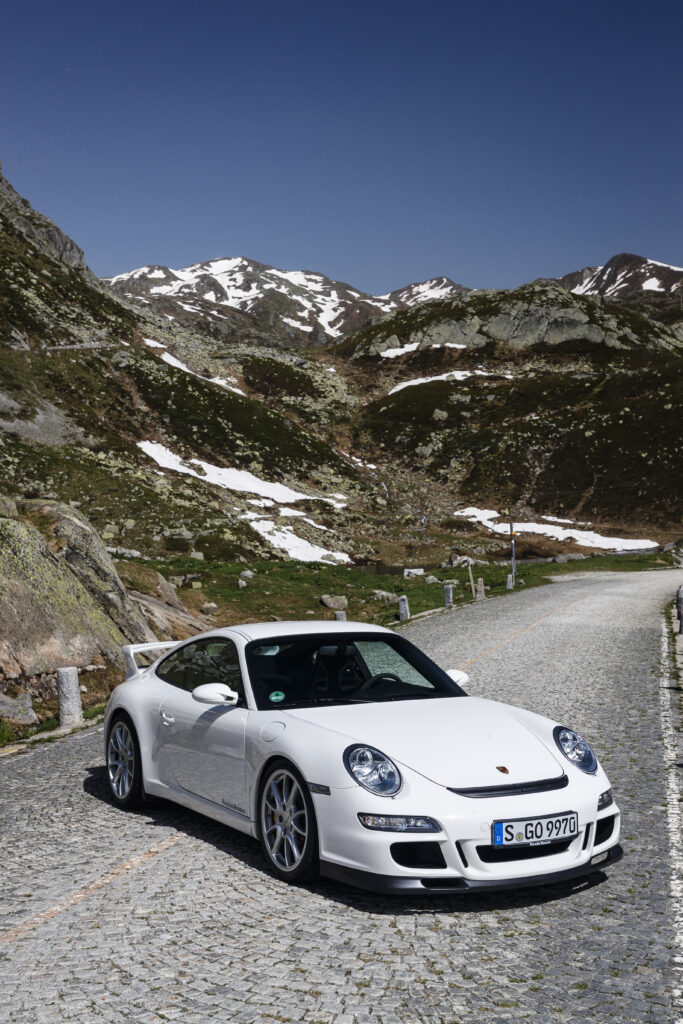
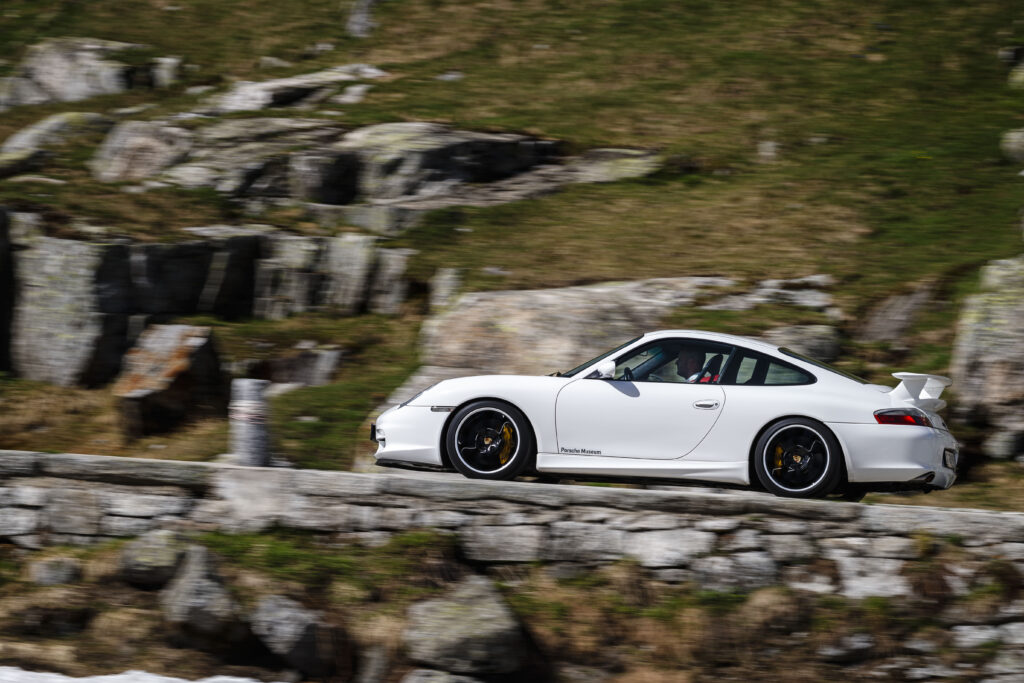
Derived from the 997-generation of the iconic 911, the 911 GT3 emerged in 2006 as a testament to Porsche's commitment to relentless performance. Powered by a refined 3.6-liter naturally aspirated flat-six engine, horsepower surged past the 400 mark, reaching an impressive 415. With an increased redline of 8,400 rpm, the 2007 911 GT3 demonstrated exhilarating acceleration, sprinting from 0 to 60 miles per hour in a mere 4.1 seconds and achieving a top track speed of 193 miles per hour.
The six-speed transmission underwent enhancements, offering 15 percent shorter shift throws and a reconfiguration of gear ratios for gears two through six. This optimization seamlessly complemented the engine's power delivery, ensuring an electrifying driving experience. To harness the increased power, the suspension system received upgrades, including divided control arms that allowed for greater adjustment of the camber angle. Additionally, Porsche Active Suspension Management (PASM) made its debut as a standard feature on the GT3, enabling electronic adjustment of the dampers for enhanced handling dynamics.
In pursuit of superior grip and handling, wheel diameters grew to 19 inches, while the standard rear cast iron brake rotors expanded to 350 mm. For even greater stopping power, optional Porsche Ceramic Composite Brake (PCCB) rotors increased to 380 mm at the front axle. Ultra-High Performance tires (UHP) were also mounted to maximize traction and cornering capability.
Breaking new ground, the 997-generation 911 GT3 introduced a traction control system (TC), complementing the standard limited-slip differential to provide drivers with enhanced control, especially on slippery surfaces. A "SPORT" button was introduced for the first time, optimizing the exhaust backpressure and activating a more dynamic mode for the traction control system.
Despite the integration of advanced technology and safety features, such as new Sport Seats with side airbags, the 911 GT3 maintained its agility, weighing in at just 3,075 lbs (1395 kg). This was achieved through the incorporation of lightweight aluminum doors and a luggage compartment lid.
Visually, the 997-generation GT3 sported distinctive styling cues, including an air outlet in front of the luggage compartment lid designed to extract air from the front center radiator, enhancing downforce at the front axle. Additionally, it was the first model to feature center-mounted tailpipes for the exhaust, further emphasizing its performance-oriented design. Inside the cabin, luxurious touches such as Alcantara-covered steering wheel, hand brake lever, and gearshift lever elevated the driving experience to new heights.
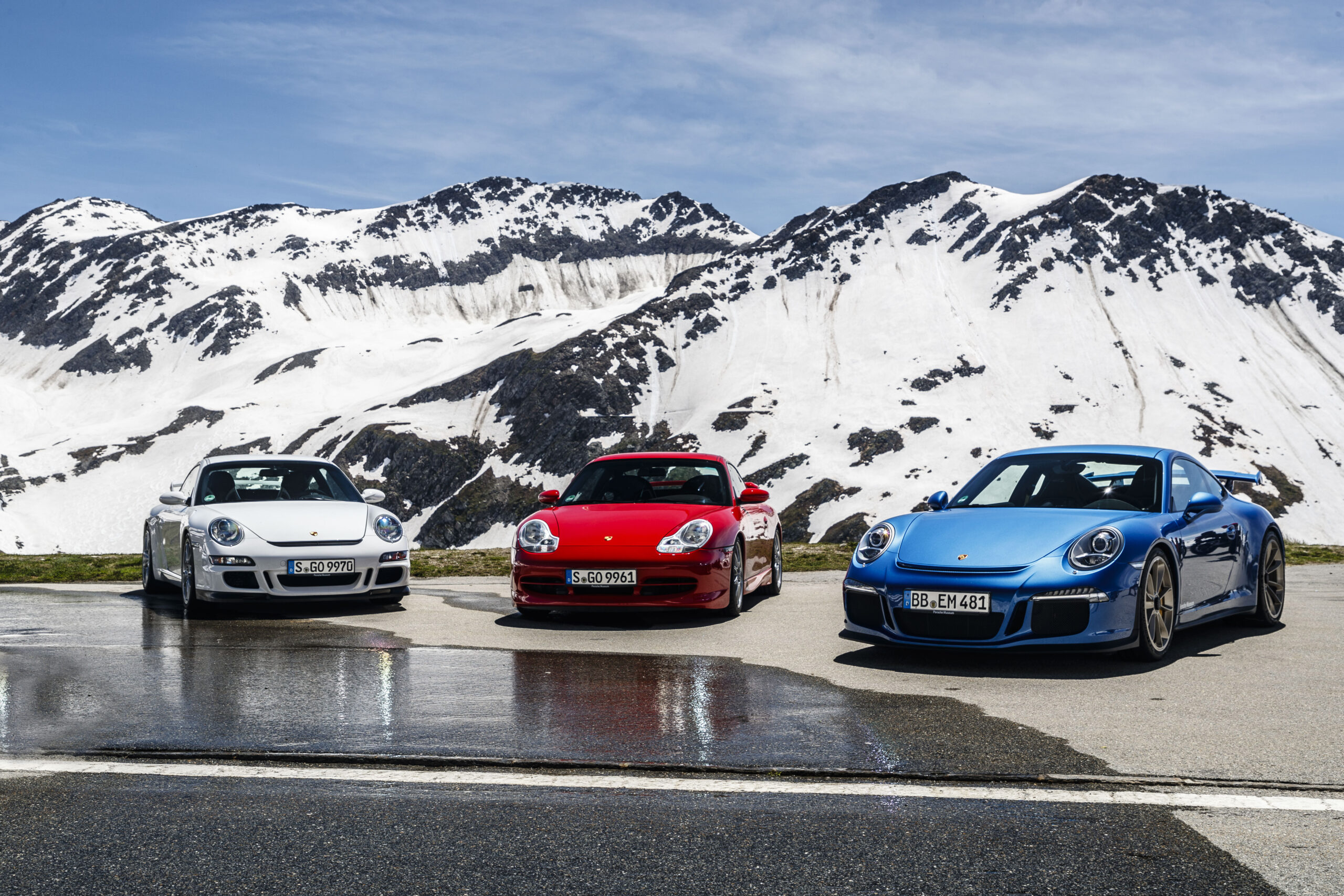
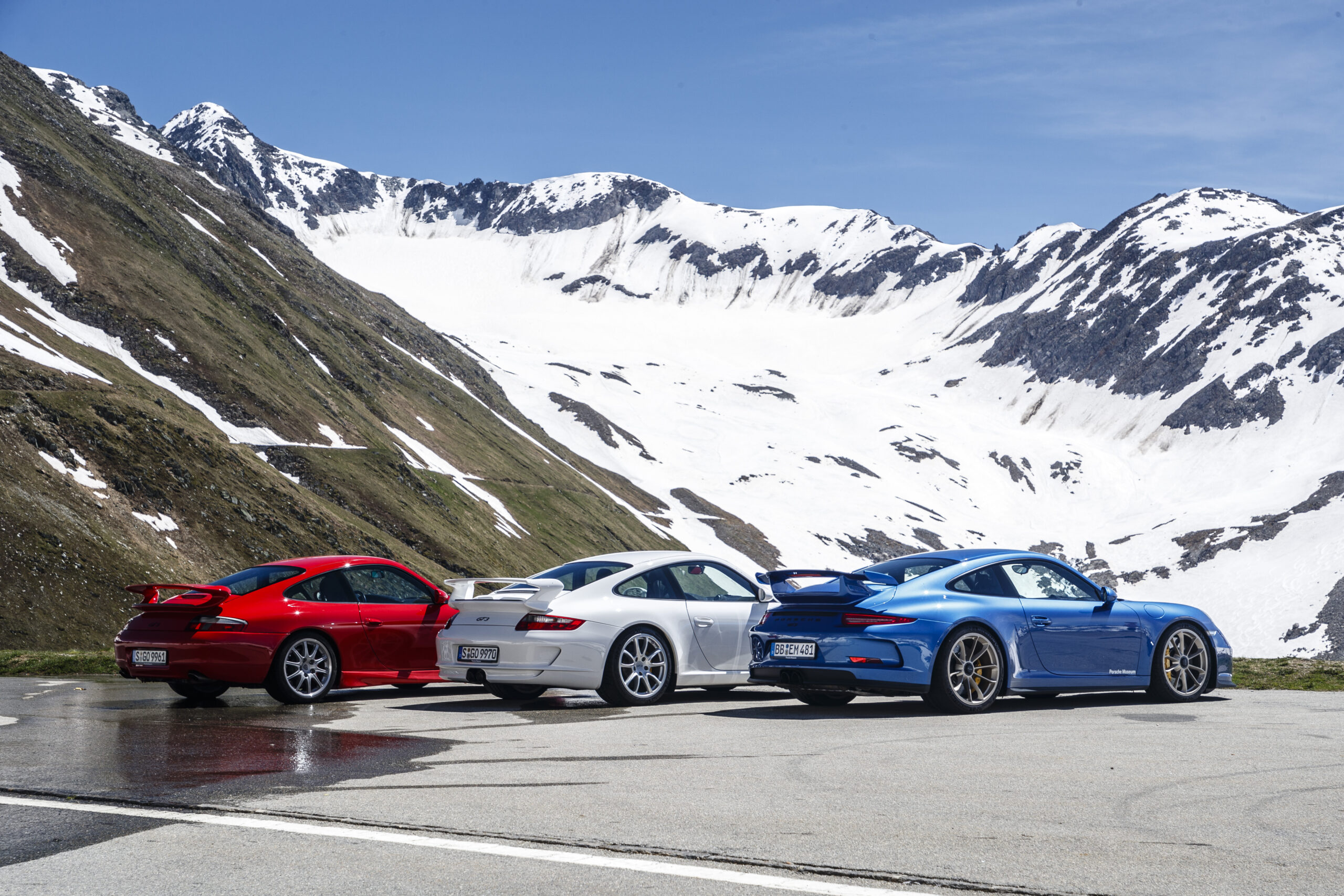
Porsche 911 GT3: 996.1, 997.1 and 991.1
In the 2010 model year, the 911 GT3 underwent a comprehensive transformation, both visually and technically, as part of the facelifted 997 generation. Signifying a significant milestone, the race-inspired flat-six engine saw an increase in displacement from 3.6 to 3.8 liters for the first time. This upgrade resulted in a power boost, with the new model delivering an impressive 435 horsepower and 317 lb-ft of torque.
With this enhanced powerplant under the hood, the 911 GT3 catapulted from 0 to 60 mph in a blistering 4.0 seconds flat, effortlessly accelerating to a top track speed of 194 miles per hour. Revving up to a staggering 8,500 rpm, the engine showcased its performance prowess with unrivaled enthusiasm.
This generation of the 911 GT3 embraced cutting-edge technology derived directly from motorsport, exemplified by the introduction of center lock hubs for the 19-inch wheels. This innovation reduced rotating masses, elevating driving performance to new heights. Furthermore, electronic stability control (ESC) was integrated, complementing the traction control system introduced in the previous model and providing an additional layer of control for the driver.
For the first time, an optional front axle lift system was introduced, offering an additional 1.2 inches (30 mm) of ride height at the front axle to navigate obstacles such as driveways and speed bumps with ease.
However, perhaps the most remarkable aspect of this iteration of the 911 GT3 was its unparalleled track performance. Equipped with the latest generation of Ultra-High Performance (UHP) tires, finely tuned Porsche Active Suspension Management (PASM), and optional dynamic engine mounts, it conquered the Nürburgring-Nordschleife in an astonishing 7 minutes and 40 seconds, showcasing its unrivaled capabilities on the track.
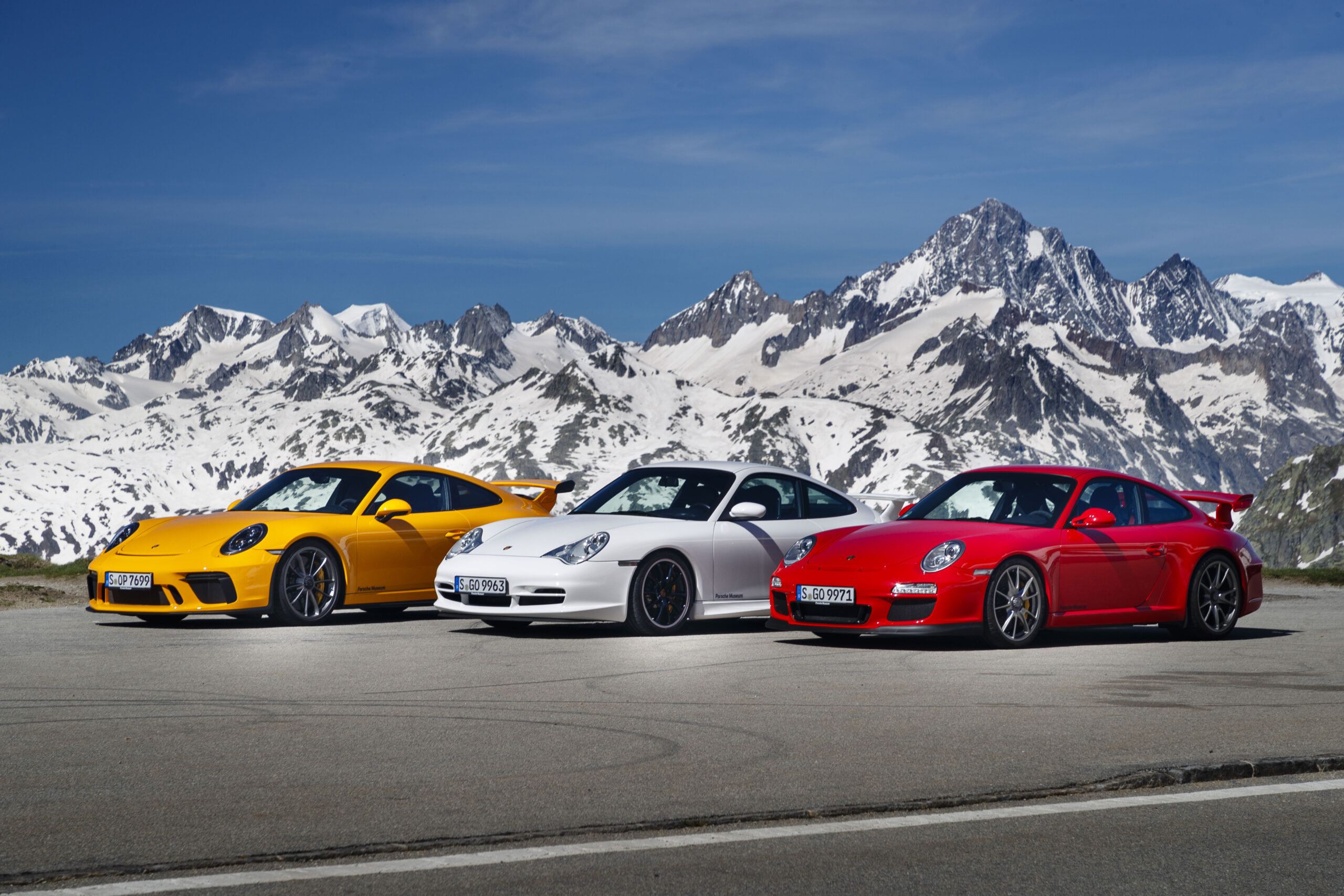
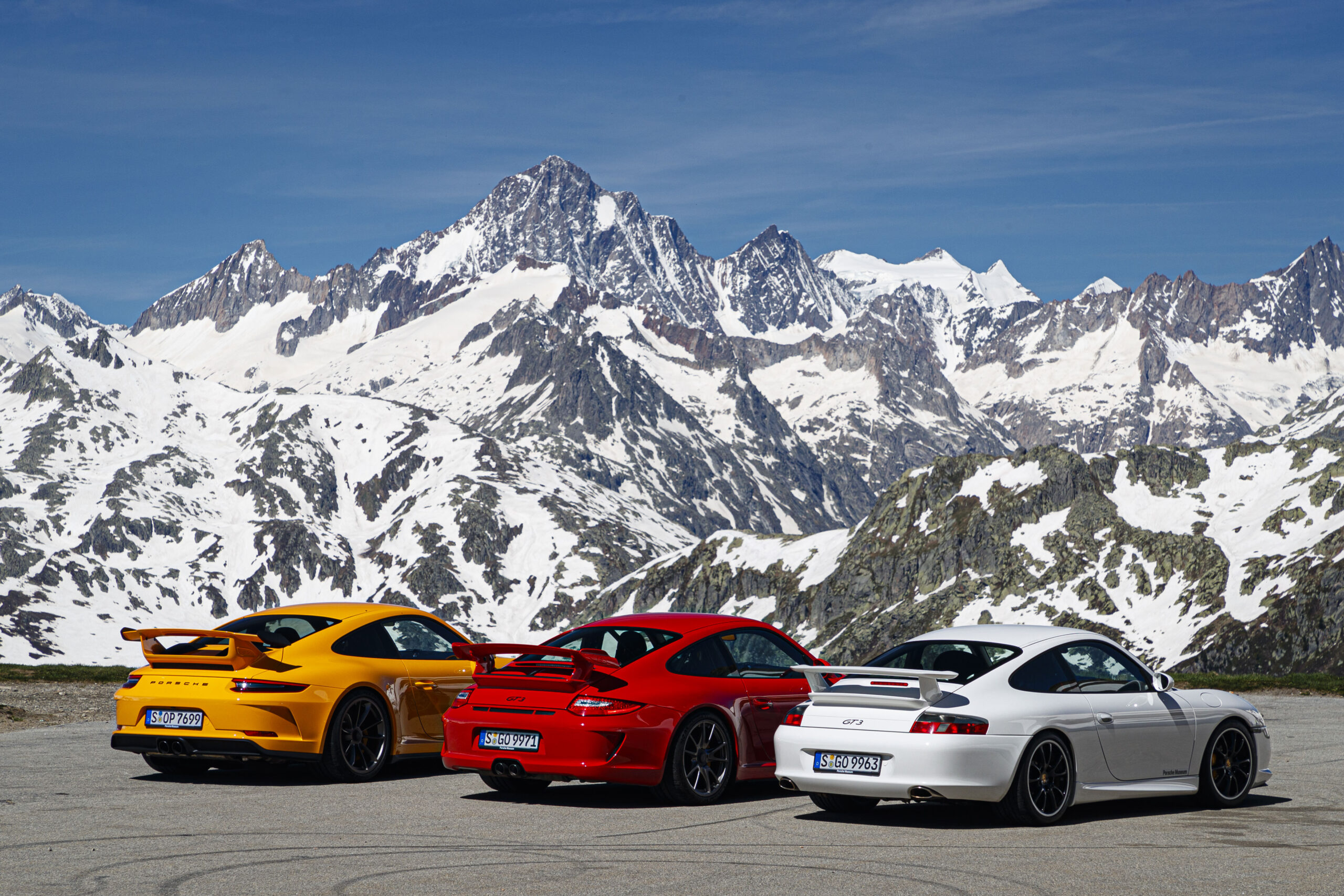
Porsche 911 GT3: 996.2,997.2 and 991.2
In 2013, for the 2014 model year, Porsche unveiled the 911 GT3 based on the newly-introduced 991-generation, marking a monumental leap in performance and technology for road cars. At its core was the groundbreaking seven-speed Porsche dual-clutch transmission (PDK), a feature previously seen in the 911 Carrera and Turbo variants of the preceding generation but now extensively reengineered to suit the demands of this track-focused model. This advanced transmission, now standard, boasted lighter gear sets, shedding approximately four pounds compared to its predecessors, and featured shortened gear ratios tailored to the high-revving nature of the naturally aspirated 475 hp 3.8-liter flat six engine.
Introducing direct injection for the first time, the engine roared to an astonishing 9,000 rpm, delivering unparalleled performance. With a top track speed of 195 mph achievable in seventh gear, and aided by the Launch Control feature and lightning-fast shifts of less than 100 milliseconds, the 911 GT3 accelerated from 0 to 60 mph in a breathtaking 3.3 seconds.
The track prowess of this latest iteration was further enhanced by the new 991 platform. Track widths and body stiffness were increased, the PASM system was refined, and standard center-lock wheels, now forged aluminum and 20 inches in diameter, were introduced for the first time. Coupled with the latest generation of Ultra-High Performance (UHP) tires and the inclusion of rear axle steering as standard—technology shared with the 918 Spyder and 911 Turbo—the GT3 delivered unparalleled agility and stability. Below 31 mph, the rear wheels steered opposite to the front for increased agility, while above 50 mph, they steered in tandem for enhanced stability during maneuvers like lane changes.
Braking capabilities were equally impressive, with cast iron brake rotors growing to 380 mm front and rear, while the optional Porsche Ceramic Composite Brake (PCCB) system, now in its third generation, boasted 410 mm rotors up front and 390 mm at the rear.
Despite the influx of advanced technology, the 2014 911 GT3 maintained its lightweight status at 3,153 lbs. Clad in a new body that generated significantly more downforce compared to its predecessors, the 911 GT3 clocked an impressive lap time of 7 minutes and 25 seconds at the Nürburgring-Nordschleife, solidifying its position as a true performance icon.

Porsche 911 GT3: 996.2 and 991.2
Clocking in at an impressive 7 minutes and 12.7 seconds, the current 911 GT3 sets a new benchmark at the Nürburgring-Nordschleife, marking a remarkable 45-second improvement compared to its original counterpart—a testament to its evolution over the years. Powering this performance machine is a potent 4.0-liter engine, churning out 500 hp and a robust 346 lb-ft of torque.
Engine durability reaches unprecedented levels with enhancements such as a new crankshaft, larger main bearings, thicker connecting rod bearings, plasma-coated cylinder liners, and an innovative oiling system that ensures optimal lubrication. Valve train clearance, akin to a racing powertrain, is factory-set using shims, eliminating the need for adjustments.
Breathing new life into the engine are larger ram air ducts atop the rear decklid cover, optimizing airflow for enhanced performance. Downforce sees a significant 20 percent increase over the previous model, reaching a total of 340 lbs (155 kg) at a top track speed of 198 mph.
This improvement is made possible by a redesigned front fascia featuring lateral air blades, a special front spoiler lip, a new rear underbody diffuser, and an imposing rear wing positioned 0.8 inches higher than before. The inclusion of lightweight materials, such as lightweight polyurethane for the front and rear fascias and carbon fiber composite for the rear decklid, further enhances performance and agility.
For enthusiasts seeking a more engaging driving experience, Porsche reintroduces the six-speed manual transmission as a no-cost alternative to the standard seven-speed PDK. Additionally, the exclusive 911 GT3 with Touring Package, first unveiled in September 2017, offers a refined driving experience by retaining the engine and suspension of the GT3 while replacing the fixed rear wing with an automatically controlled rear spoiler from the 911 Carrera Cabriolet models, complete with an additional Gurney flap. Chrome accents and cloth seat inserts provide a touch of elegance to this variant.
More capable and diverse than ever before, the 911 GT3 epitomizes Porsche's unwavering commitment to crafting pure, uncompromised sports cars—a testament to its enduring legacy of performance excellence.
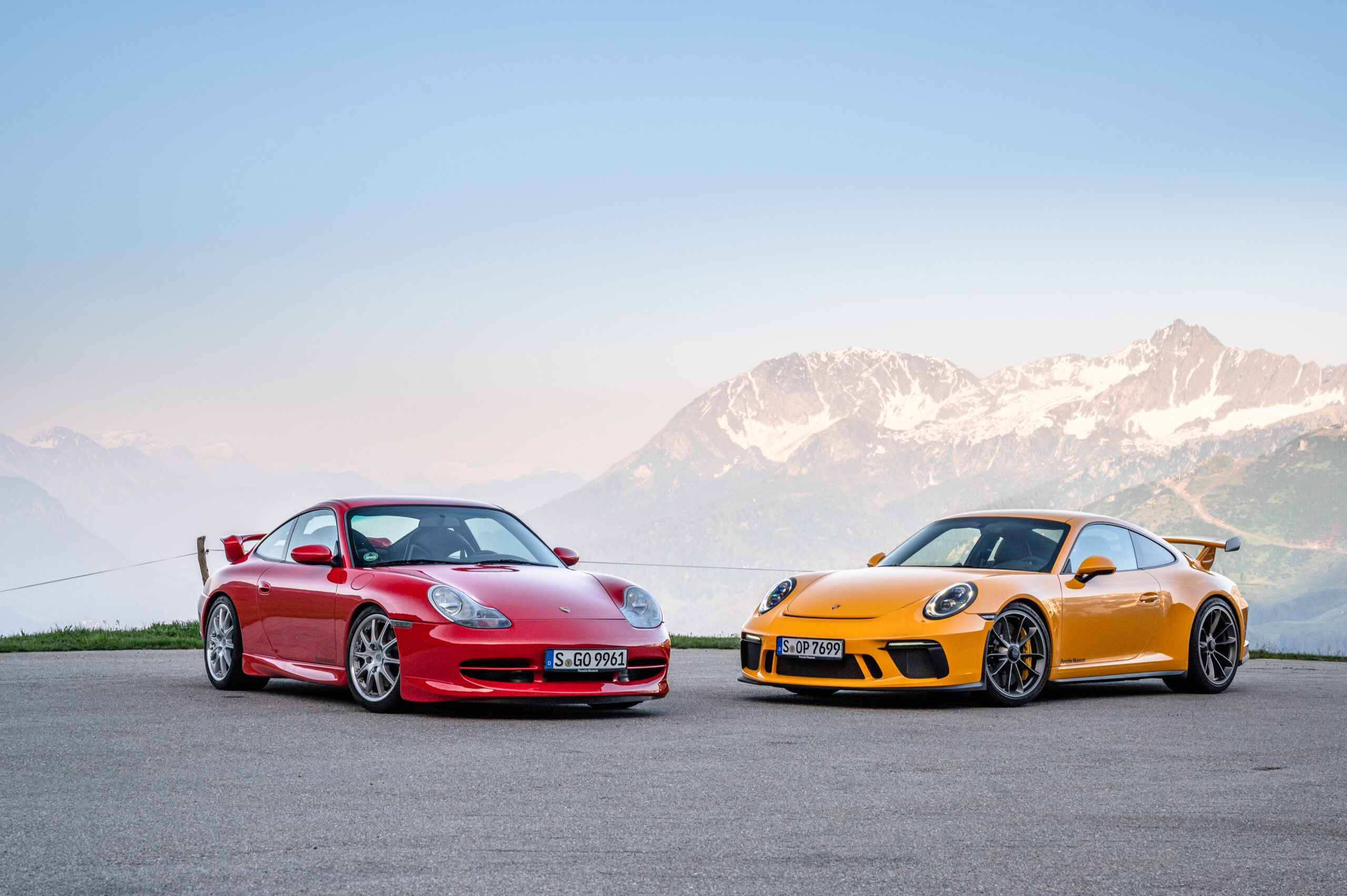
Porsche 911 GT3: First (996.1) and latest generation (991.2)
